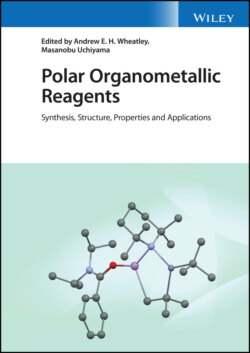Читать книгу Polar Organometallic Reagents - Группа авторов - Страница 20
1.3.4 Solid‐phase Synthesis
ОглавлениеSolid‐phase synthesis has become a recognized and attractive methodology for constructing libraries of biologically active small molecules in connection with combinatorial chemistry and automated synthesis oriented towards drug discovery research [166]. Various synthetic methodologies have been applied to solid‐phase synthesis [167]; however, organometallic chemistry has not yet been well explored in this area due to the lack of effective preparative methods of immobilized organometallic compounds for reaction with electrophilic linkages such as esters. That said, organometallic compounds have played an important role in solution‐phase chemistry for selective carbon–carbon bond forming reactions directed toward construction of complex molecules. This has led to the development of new solid phase carbon–carbon bond forming processes, with the halogen–metal exchange reaction of organic halides supported on polymer with an electrophilic linkage being the target of investigation [168]. The ate complexes t‐Bu3ZnLi 65 and (Me3SiCH2)2Cu(CN)Li2117 turned out to be very effective as the solid phase metalating agents in this context (Scheme 1.25). Various modes of carbon–carbon bond formation were achieved using immobilized arylmetal ate complexes, including 1,2‐addition to benzaldehyde, 1,4‐addition to 2‐cyclohexenone, and alkylations with methyl iodide and allyl iodide (118–120). Meanwhile, the metalation of insoluble polymers such as cross‐linked polystyrene has been investigated in connection with the preparation of materials for polymer‐assisted chemistry, with lithiation routinely being used for the functionalization of polystyrene resin. However, this approach has typically been restricted to examples where electrophilic functional groups are not present, and only a few reports of the solid phase lithiation of immobilized small molecules bearing electrophilic functional groups have appeared in the literature. In spite of these limitations, solid‐state synthesis has retained its appeal where functional groups not compatible with solution derivatization are concerned. For example, organometallic compounds containing an alkoxycarbonyl group are typically unstable at elevated temperatures due to self‐condensation or homocoupling. Immobilized organometallic compounds, on the other hand, have a track record of demonstrating enhanced stability, even when they bear highly reactive electrophilic groups, because of the diminished chance of self‐condensation and homocoupling by pseudo‐dilution effects. In the face, however, of the intrinsic limitations of traditional monometallic reagents, there has been great interest in developing new ways for the chemoselective metalation of small molecules on polystyrene, and this has focused on the use of metalating agents capable of being used in tandem with the presence of electrophilic functional groups. It is in this context that chemoselective solid‐phase halogen–metal exchange reactions, focusing principally on the preparation and transformation of immobilized intermediary organozincate and organocuprate species, have been investigated by Kondo and coworkers. Cahiez, Knochel, and coworkers also reported that the relevant halogen–metal exchange takes place using a Grignard reagent [169].
Scheme 1.25 Use of ate complex t‐Bu3ZnLi 65 as a solid‐phase metalating agent.
